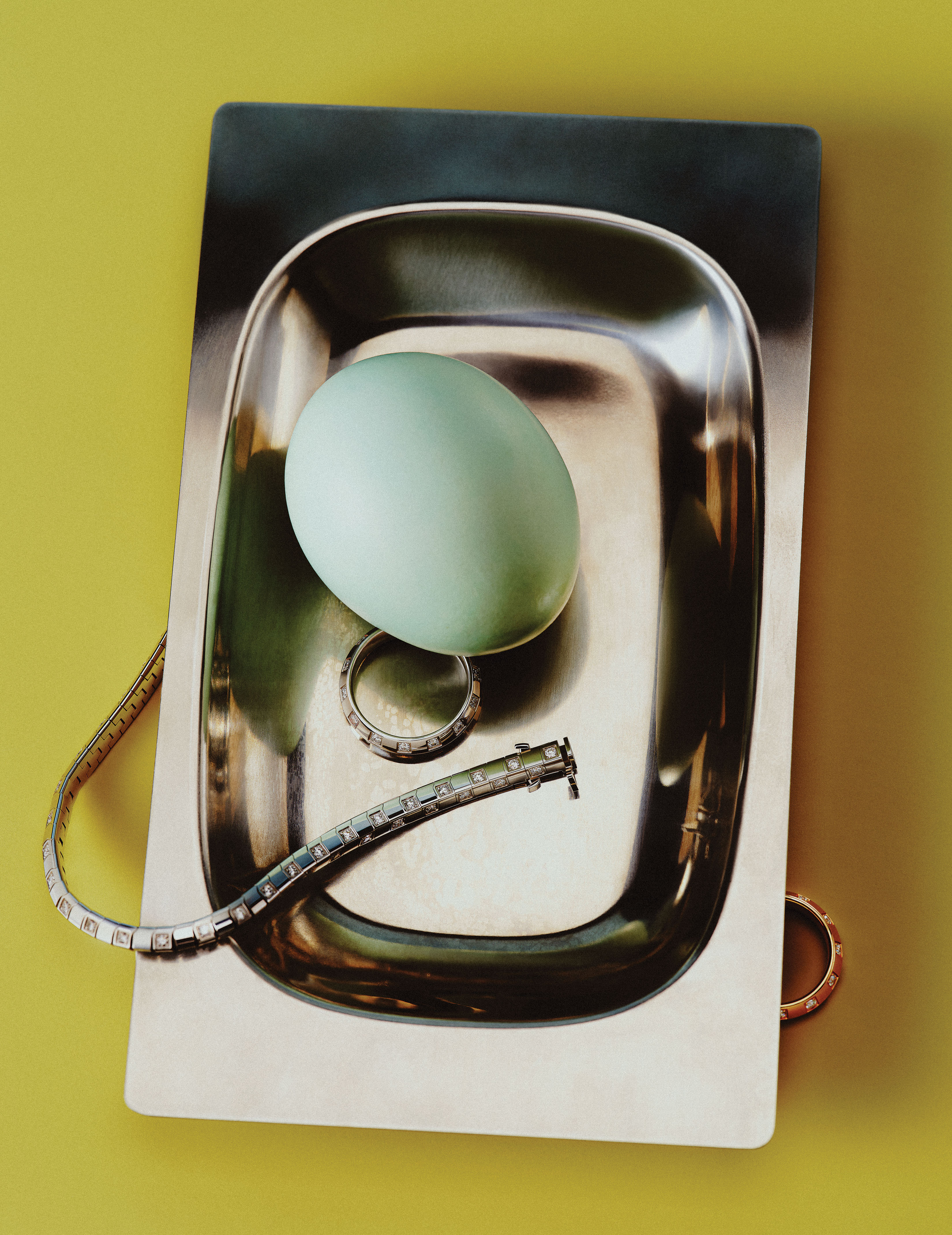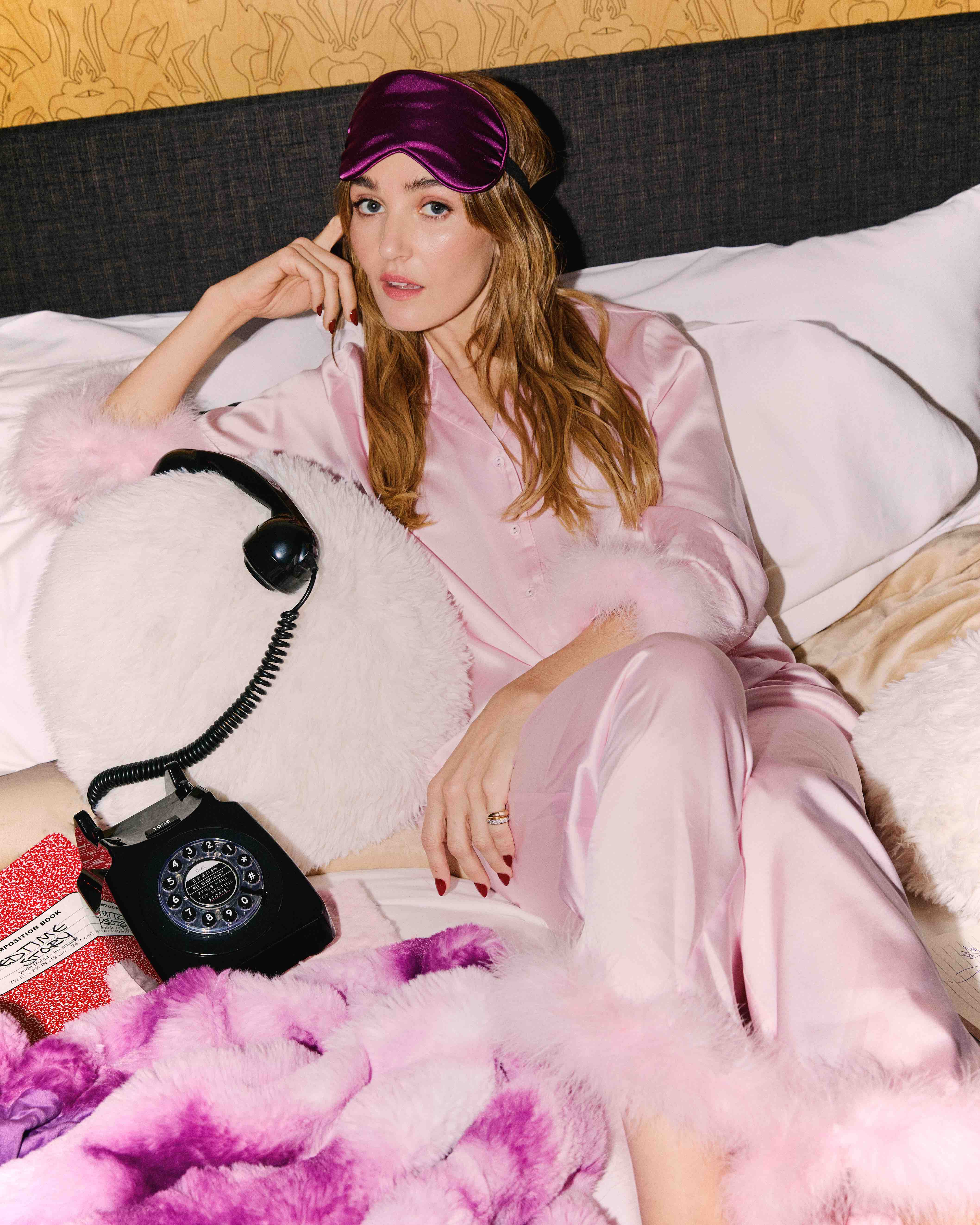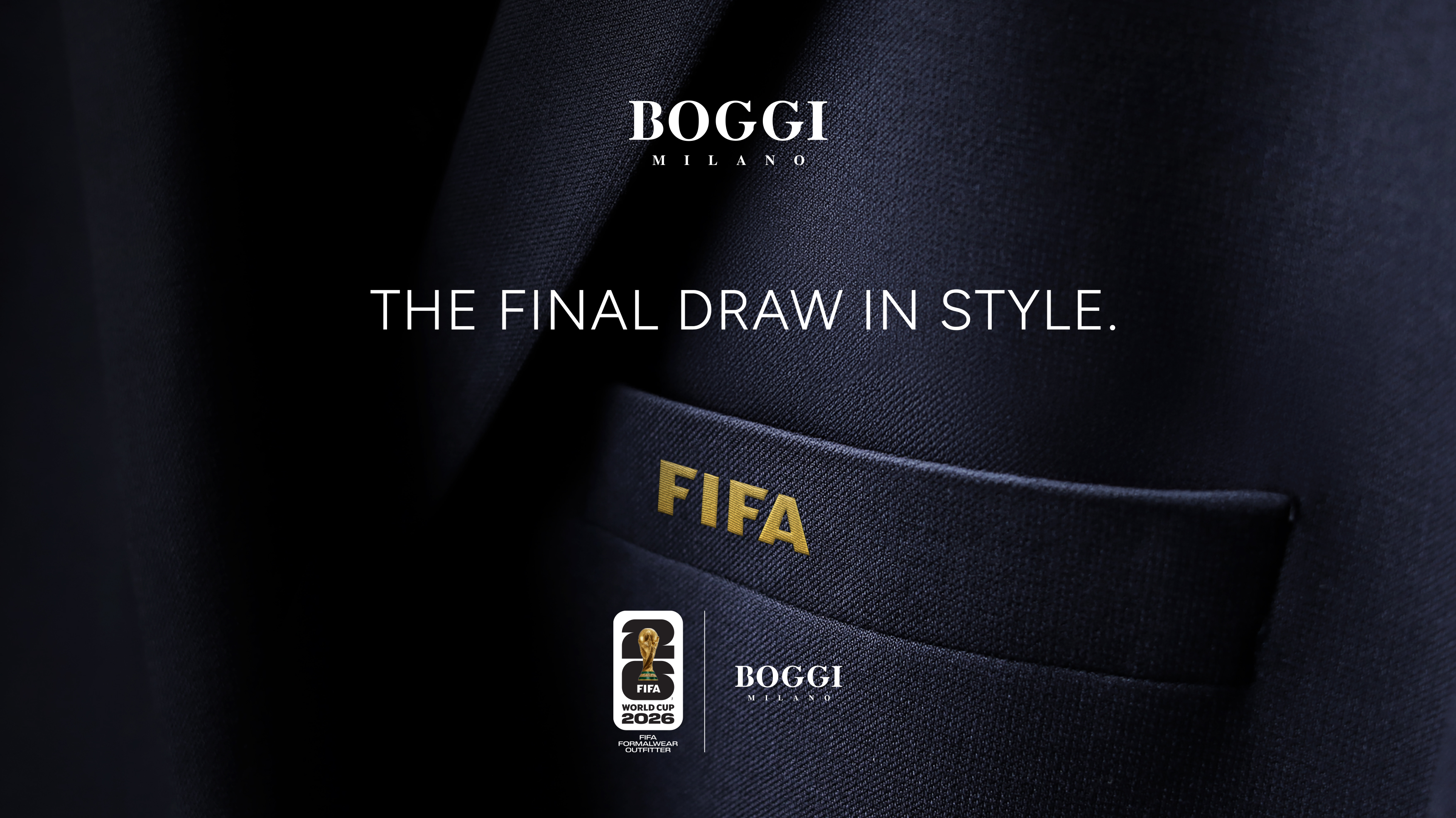[ISA BOULDER](https://isaboulder.com/) is the eco-conscious, bespoke brand founded by two Indonesian designers based in Bali. Highlighting the craftsmanship of their local artisans, the designers follow a made-to-order model to hone in traditional practices and slow down an otherwise overwhelmed fashion cycle. With the launch of their exclusive SS20 capsule collection with [MatchesFashion](https://www.matchesfashion.com/us/womens/designers/isa-boulder), we spoke with the ISA BOULDER team.


**_How did Isa Boulder come to be?_**
We started about 2 years ago when the opportunity arose for us to set up a small company with a few then unemployed seamstresses we were acquaintances with. Skilled seamstresses are hard to come by and we didn’t want to miss out on the opportunity to finally embark on this venture together. It has probably worked well for us as a team because we feed off each other’s experiences and creativity. It is not without its challenges but we have become like family and we can’t bear to just quit and give everything up at this point despite facing some setbacks. The satisfaction we get from working towards our common goal of highlighting local craftsmanship, is what binds us together. As Indonesians, we feel very proud to be producing high-quality items made locally, and proving that we are not any less capable than design companies overseas.
**_Your team, including the local artisan community, is central to the company. How much of that heritage is reflected in ISA BOULDER’s designs and production?_**
Our first collection was based around swimwear partly because our seamstresses came from that background and we believed creating a swimwear collection would really showcase their expertise and produce the best results. We would like to think that we’re not just a “swimwear” / “knitwear” / “womenswear” label and not simply put our brand into a certain mold or restrict ourselves into to a specific discipline.
We hope that with whatever we design, we are able to reflect on the ingenuity of our local artisans and truly showcase their talents. Everything of quality takes time, and even for production, we don’t treat our in-house seamstresses or the freelance artisans we work with, like factory workers and expect them to churn out the same amount of items each day. It wouldn’t work. We respect the process and give them the space and time to excel at their art. Just like how a musician will not find perfection despite having practiced the same notes for years, they’re honing their craft each day and there is no set rules.


#block-yui\_3\_17\_2\_1\_1588365461209\_20117 .sqs-gallery-block-grid { margin-right: -10px; } #block-yui\_3\_17\_2\_1\_1588365461209\_20117 .sqs-gallery-block-grid .sqs-gallery-design-grid-slide .margin-wrapper { margin-right: 10px; margin-bottom: 10px; }
**_Do you believe consumers are shifting towards a slow-fashion mindset? How has this impacted your made-to-order practice?_**
As more disasters and man-made tragedies happen around us, people can no longer ignore the real-life consequences this little distraction we have created for ourselves, called Fashion, is causing. Consumers are definitely becoming more considerate and proactive towards being a part of a positive change, which is so crucial since they are the driving force of the whole industry. It has also become our responsibility as designers to emphasize the value of patience and craft. Like any other businesses, the fashion business thrives on renewal and constantly selling. It has become a conundrum for us too— to stay relevant and have a large enough selection for buyers to choose from, and yet not unnecessarily produce things.
Hopefully, by having a made-to-order aspect of our business, we are able to control the wastage albeit producing at a much higher cost. It has also transcended being a simple transaction for the sale of a piece of clothing and more about the connection that we are making with our wearers— creating an item that our customers feel is worth their time to get perfect. Also, we believe that when a garment fits us well or feel tailor-made to us, we have a stronger personal attachment towards it, and hence less likely to throw away or part with. This is definitely a positive and encouraging aspect of bespoke that we hope our customers also believe in.
**_What is your viewpoint on daily-dress, and its reflection of individuality vs. societal trends?_**
Generally, people are looking inwards, and prioritizing what they physically feel comfortable in or what they personally think is cool as opposed to what others think or what others want to make them think. This is perhaps due to the over saturation of media and the boredom with style references/ influences that is so readily accessible to us. Looking different is no longer a priority, expressing individuality doesn’t have to be as obvious as through our appearance. It could be a lifestyle choice you make, like rotating the same pieces of clothing you have, which is much more personal and meaningful. We were never the type to adhere to societal trends, but for sure there is a certain aesthetic or mood that we could all be “into” as a generation, and experiencing the same fascination during the same period of time— which is fine as long as we are genuine about it and truly embracing that “trend” with our own take on it.


#block-yui\_3\_17\_2\_1\_1588365461209\_29506 .sqs-gallery-block-grid { margin-right: -10px; } #block-yui\_3\_17\_2\_1\_1588365461209\_29506 .sqs-gallery-block-grid .sqs-gallery-design-grid-slide .margin-wrapper { margin-right: 10px; margin-bottom: 10px; }
**_Why is knitwear the future of sustainable fashion? How do you envision knitwear evolving in the industry?_**
On one spectrum of knitwear like performance-based knits, people boast with terms like “sweat-absorbing” “hydrophobic” “seamless” and then you have this other aspect with hand-knits which is almost primitive and imperfect. It is cool that computerized machines can make knits with super fine gauge—perhaps reflective of the sleekness of our modern times— but it lacks the hand-made characteristics that knits are traditionally loved for. Both methods are definitely inspiring and have endless design possibilities. However, there is a beauty in the tactility of hand-made knits and its almost crudeness which represents a longing for the human touch.. the nostalgia attached to hand-me-downs or garments made by someone who loved us.
This real human wabi-sabi quality is irreplaceable but is perhaps itself an aesthetic that is worth exploring even it is through non hand-made means. We continuously marvel at the technology of computerized knits but I guess due to the lower price or maybe the look of the end result, people tend to forget that it went through a process to get made, and they can seem so disposable to some consumers. You think twice throwing something hand-made just because there is this humanity to it. Knits, hand-made or computerized, its production methods can be more friendly to the environment because it virtually leaves no material wastage. “Sustainable fashion” can seem like an oxymoron at times and my interpretation of sustainable fashion is a system, where we could keep up with the pace, at which we are making these garments at. Besides embracing the sustainable aspect of production, we also have to give designs time to breathe and let it exist and be appreciated for much longer than we have allowed it. How can we deem something redundant when it was barely made a few months/years ago? Maybe it is the fragile nature of knitwear and how we are forced to give extra care for these garments or maybe how it closely hugs our skin and keeps us cozy.. we naturally have more sentimentality towards it.


* * *
 
**_How did Isa Boulder come to be?_**
We started about 2 years ago when the opportunity arose for us to set up a small company with a few then unemployed seamstresses we were acquaintances with. Skilled seamstresses are hard to come by and we didn’t want to miss out on the opportunity to finally embark on this venture together. It has probably worked well for us as a team because we feed off each other’s experiences and creativity. It is not without its challenges but we have become like family and we can’t bear to just quit and give everything up at this point despite facing some setbacks. The satisfaction we get from working towards our common goal of highlighting local craftsmanship, is what binds us together. As Indonesians, we feel very proud to be producing high-quality items made locally, and proving that we are not any less capable than design companies overseas.
**_Your team, including the local artisan community, is central to the company. How much of that heritage is reflected in ISA BOULDER’s designs and production?_**
Our first collection was based around swimwear partly because our seamstresses came from that background and we believed creating a swimwear collection would really showcase their expertise and produce the best results. We would like to think that we’re not just a “swimwear” / “knitwear” / “womenswear” label and not simply put our brand into a certain mold or restrict ourselves into to a specific discipline.
We hope that with whatever we design, we are able to reflect on the ingenuity of our local artisans and truly showcase their talents. Everything of quality takes time, and even for production, we don’t treat our in-house seamstresses or the freelance artisans we work with, like factory workers and expect them to churn out the same amount of items each day. It wouldn’t work. We respect the process and give them the space and time to excel at their art. Just like how a musician will not find perfection despite having practiced the same notes for years, they’re honing their craft each day and there is no set rules.


#block-yui\_3\_17\_2\_1\_1588365461209\_20117 .sqs-gallery-block-grid { margin-right: -10px; } #block-yui\_3\_17\_2\_1\_1588365461209\_20117 .sqs-gallery-block-grid .sqs-gallery-design-grid-slide .margin-wrapper { margin-right: 10px; margin-bottom: 10px; }
**_Do you believe consumers are shifting towards a slow-fashion mindset? How has this impacted your made-to-order practice?_**
As more disasters and man-made tragedies happen around us, people can no longer ignore the real-life consequences this little distraction we have created for ourselves, called Fashion, is causing. Consumers are definitely becoming more considerate and proactive towards being a part of a positive change, which is so crucial since they are the driving force of the whole industry. It has also become our responsibility as designers to emphasize the value of patience and craft. Like any other businesses, the fashion business thrives on renewal and constantly selling. It has become a conundrum for us too— to stay relevant and have a large enough selection for buyers to choose from, and yet not unnecessarily produce things.
Hopefully, by having a made-to-order aspect of our business, we are able to control the wastage albeit producing at a much higher cost. It has also transcended being a simple transaction for the sale of a piece of clothing and more about the connection that we are making with our wearers— creating an item that our customers feel is worth their time to get perfect. Also, we believe that when a garment fits us well or feel tailor-made to us, we have a stronger personal attachment towards it, and hence less likely to throw away or part with. This is definitely a positive and encouraging aspect of bespoke that we hope our customers also believe in.
**_What is your viewpoint on daily-dress, and its reflection of individuality vs. societal trends?_**
Generally, people are looking inwards, and prioritizing what they physically feel comfortable in or what they personally think is cool as opposed to what others think or what others want to make them think. This is perhaps due to the over saturation of media and the boredom with style references/ influences that is so readily accessible to us. Looking different is no longer a priority, expressing individuality doesn’t have to be as obvious as through our appearance. It could be a lifestyle choice you make, like rotating the same pieces of clothing you have, which is much more personal and meaningful. We were never the type to adhere to societal trends, but for sure there is a certain aesthetic or mood that we could all be “into” as a generation, and experiencing the same fascination during the same period of time— which is fine as long as we are genuine about it and truly embracing that “trend” with our own take on it.


#block-yui\_3\_17\_2\_1\_1588365461209\_29506 .sqs-gallery-block-grid { margin-right: -10px; } #block-yui\_3\_17\_2\_1\_1588365461209\_29506 .sqs-gallery-block-grid .sqs-gallery-design-grid-slide .margin-wrapper { margin-right: 10px; margin-bottom: 10px; }
**_Why is knitwear the future of sustainable fashion? How do you envision knitwear evolving in the industry?_**
On one spectrum of knitwear like performance-based knits, people boast with terms like “sweat-absorbing” “hydrophobic” “seamless” and then you have this other aspect with hand-knits which is almost primitive and imperfect. It is cool that computerized machines can make knits with super fine gauge—perhaps reflective of the sleekness of our modern times— but it lacks the hand-made characteristics that knits are traditionally loved for. Both methods are definitely inspiring and have endless design possibilities. However, there is a beauty in the tactility of hand-made knits and its almost crudeness which represents a longing for the human touch.. the nostalgia attached to hand-me-downs or garments made by someone who loved us.
This real human wabi-sabi quality is irreplaceable but is perhaps itself an aesthetic that is worth exploring even it is through non hand-made means. We continuously marvel at the technology of computerized knits but I guess due to the lower price or maybe the look of the end result, people tend to forget that it went through a process to get made, and they can seem so disposable to some consumers. You think twice throwing something hand-made just because there is this humanity to it. Knits, hand-made or computerized, its production methods can be more friendly to the environment because it virtually leaves no material wastage. “Sustainable fashion” can seem like an oxymoron at times and my interpretation of sustainable fashion is a system, where we could keep up with the pace, at which we are making these garments at. Besides embracing the sustainable aspect of production, we also have to give designs time to breathe and let it exist and be appreciated for much longer than we have allowed it. How can we deem something redundant when it was barely made a few months/years ago? Maybe it is the fragile nature of knitwear and how we are forced to give extra care for these garments or maybe how it closely hugs our skin and keeps us cozy.. we naturally have more sentimentality towards it.

**_How did Isa Boulder come to be?_**
We started about 2 years ago when the opportunity arose for us to set up a small company with a few then unemployed seamstresses we were acquaintances with. Skilled seamstresses are hard to come by and we didn’t want to miss out on the opportunity to finally embark on this venture together. It has probably worked well for us as a team because we feed off each other’s experiences and creativity. It is not without its challenges but we have become like family and we can’t bear to just quit and give everything up at this point despite facing some setbacks. The satisfaction we get from working towards our common goal of highlighting local craftsmanship, is what binds us together. As Indonesians, we feel very proud to be producing high-quality items made locally, and proving that we are not any less capable than design companies overseas.
**_Your team, including the local artisan community, is central to the company. How much of that heritage is reflected in ISA BOULDER’s designs and production?_**
Our first collection was based around swimwear partly because our seamstresses came from that background and we believed creating a swimwear collection would really showcase their expertise and produce the best results. We would like to think that we’re not just a “swimwear” / “knitwear” / “womenswear” label and not simply put our brand into a certain mold or restrict ourselves into to a specific discipline.
We hope that with whatever we design, we are able to reflect on the ingenuity of our local artisans and truly showcase their talents. Everything of quality takes time, and even for production, we don’t treat our in-house seamstresses or the freelance artisans we work with, like factory workers and expect them to churn out the same amount of items each day. It wouldn’t work. We respect the process and give them the space and time to excel at their art. Just like how a musician will not find perfection despite having practiced the same notes for years, they’re honing their craft each day and there is no set rules.


#block-yui\_3\_17\_2\_1\_1588365461209\_20117 .sqs-gallery-block-grid { margin-right: -10px; } #block-yui\_3\_17\_2\_1\_1588365461209\_20117 .sqs-gallery-block-grid .sqs-gallery-design-grid-slide .margin-wrapper { margin-right: 10px; margin-bottom: 10px; }
**_Do you believe consumers are shifting towards a slow-fashion mindset? How has this impacted your made-to-order practice?_**
As more disasters and man-made tragedies happen around us, people can no longer ignore the real-life consequences this little distraction we have created for ourselves, called Fashion, is causing. Consumers are definitely becoming more considerate and proactive towards being a part of a positive change, which is so crucial since they are the driving force of the whole industry. It has also become our responsibility as designers to emphasize the value of patience and craft. Like any other businesses, the fashion business thrives on renewal and constantly selling. It has become a conundrum for us too— to stay relevant and have a large enough selection for buyers to choose from, and yet not unnecessarily produce things.
Hopefully, by having a made-to-order aspect of our business, we are able to control the wastage albeit producing at a much higher cost. It has also transcended being a simple transaction for the sale of a piece of clothing and more about the connection that we are making with our wearers— creating an item that our customers feel is worth their time to get perfect. Also, we believe that when a garment fits us well or feel tailor-made to us, we have a stronger personal attachment towards it, and hence less likely to throw away or part with. This is definitely a positive and encouraging aspect of bespoke that we hope our customers also believe in.
**_What is your viewpoint on daily-dress, and its reflection of individuality vs. societal trends?_**
Generally, people are looking inwards, and prioritizing what they physically feel comfortable in or what they personally think is cool as opposed to what others think or what others want to make them think. This is perhaps due to the over saturation of media and the boredom with style references/ influences that is so readily accessible to us. Looking different is no longer a priority, expressing individuality doesn’t have to be as obvious as through our appearance. It could be a lifestyle choice you make, like rotating the same pieces of clothing you have, which is much more personal and meaningful. We were never the type to adhere to societal trends, but for sure there is a certain aesthetic or mood that we could all be “into” as a generation, and experiencing the same fascination during the same period of time— which is fine as long as we are genuine about it and truly embracing that “trend” with our own take on it.


#block-yui\_3\_17\_2\_1\_1588365461209\_29506 .sqs-gallery-block-grid { margin-right: -10px; } #block-yui\_3\_17\_2\_1\_1588365461209\_29506 .sqs-gallery-block-grid .sqs-gallery-design-grid-slide .margin-wrapper { margin-right: 10px; margin-bottom: 10px; }
**_Why is knitwear the future of sustainable fashion? How do you envision knitwear evolving in the industry?_**
On one spectrum of knitwear like performance-based knits, people boast with terms like “sweat-absorbing” “hydrophobic” “seamless” and then you have this other aspect with hand-knits which is almost primitive and imperfect. It is cool that computerized machines can make knits with super fine gauge—perhaps reflective of the sleekness of our modern times— but it lacks the hand-made characteristics that knits are traditionally loved for. Both methods are definitely inspiring and have endless design possibilities. However, there is a beauty in the tactility of hand-made knits and its almost crudeness which represents a longing for the human touch.. the nostalgia attached to hand-me-downs or garments made by someone who loved us.
This real human wabi-sabi quality is irreplaceable but is perhaps itself an aesthetic that is worth exploring even it is through non hand-made means. We continuously marvel at the technology of computerized knits but I guess due to the lower price or maybe the look of the end result, people tend to forget that it went through a process to get made, and they can seem so disposable to some consumers. You think twice throwing something hand-made just because there is this humanity to it. Knits, hand-made or computerized, its production methods can be more friendly to the environment because it virtually leaves no material wastage. “Sustainable fashion” can seem like an oxymoron at times and my interpretation of sustainable fashion is a system, where we could keep up with the pace, at which we are making these garments at. Besides embracing the sustainable aspect of production, we also have to give designs time to breathe and let it exist and be appreciated for much longer than we have allowed it. How can we deem something redundant when it was barely made a few months/years ago? Maybe it is the fragile nature of knitwear and how we are forced to give extra care for these garments or maybe how it closely hugs our skin and keeps us cozy.. we naturally have more sentimentality towards it.
 
* * *

* * *


















